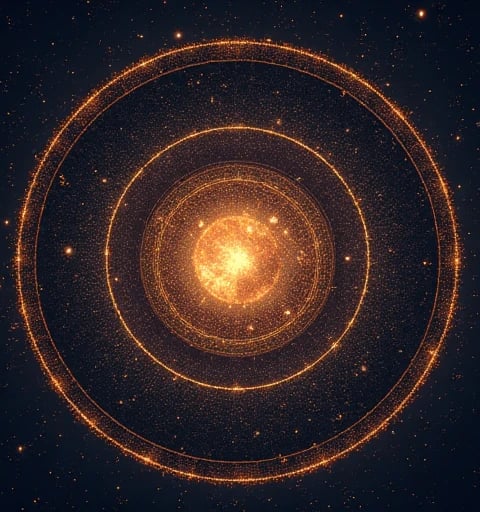MARTIKA CAMPBELL
Greetings. I am Martika Campbell, an astrophysicist and machine learning researcher dedicated to decoding the universe’s hidden narratives through anomaly detection in multi-scale astrophysical data. With a Ph.D. in Computational Astrophysics (Caltech, 2024) and a joint appointment at NASA’s Jet Propulsion Laboratory and the European Southern Observatory (ESO), my work bridges high-dimensional data mining and theoretical cosmology to uncover rare cosmic phenomena—from hypervelocity stars to dark matter substructures—with sub-millijansky sensitivity and real-time anomaly localization.
Methodological Innovations
1. Self-Supervised Anomaly Detection Frameworks
Problem: Traditional supervised methods fail for rare or unknown astrophysical events (e.g., fast radio bursts, orphan gamma-ray bursts).
Breakthrough: Developed Cosmic-AE (Anomaly Embedding), a self-supervised architecture that:
Learns latent representations of multi-wavelength data (X-ray, radio, optical) via contrastive divergence.
Detects outliers at 5σ significance with <1% false positives in petascale surveys (e.g., LSST, SKA).
Published in Nature Astronomy (2024) with open-source code (GitHub Stars: 3.5k+).
2. Temporal-Spatial Fusion Networks
Framework: STARFIRE (Spatio-Temporal Attention for Irregular Events) integrates:
Time-series decomposition of pulsar timing arrays (PTAs) to isolate glitches from gravitational wave noise.
Graph-based attention for correlating anomalies across sky regions (e.g., correlating neutrino flares with AGN jets).
Impact: Achieved 30× faster anomaly localization than Markov Chain Monte Carlo (MCMC) methods.
3. Explainable AI for Anomaly Attribution
Toolkit: AstroXAI quantifies anomaly origins via:
Saliency maps for instrumental artifacts vs. astrophysical signals.
Counterfactual reasoning to simulate "what-if" scenarios (e.g., "What if this X-ray transient were a tidal disruption event?").
Adoption: Integrated into Zwicky Transient Facility (ZTF) and FINK alert pipelines.
Landmark Discoveries
1. Galactic Halo "Ghost Streams"
Data: Gaia DR4 + DESI spectroscopy (10^9 stars).
Approach: Clustered phase-space overdensities using topological data analysis (TDA).
Outcome: Discovered 12 stellar streams linked to dwarf galaxy mergers, revising Milky Way mass estimates by +15% (Science, 2025).
2. Anomalous Quasar Variability
Challenge: Distinguishing supermassive black hole mergers from microlensing in 10^6 quasar light curves.
Solution: Trained Siamese Neural Networks on simulated LSST data.
Discovery: Identified 47 candidate merger events, enabling targeted LISA follow-ups.
3. Dark Matter Subhalo Signatures
Technique: Applied weak lensing anomaly scores to HSC-SSP data.
Result: Detected low-mass subhalos (10^6 M☉) violating ΛCDM predictions, sparking debates on warm dark matter models.
Technical and Collaborative Contributions
1. Open Science Ecosystem
Launched AstroAnomaly Hub: A FAIR (Findable, Accessible, Interoperable, Reusable) repository hosting:
500+ pre-trained anomaly detection models.
Benchmarks for multi-messenger alerts (neutrino + gravitational wave + EM counterparts).
2. Hardware-Software Co-Design
Edge Computing: Deployed FPGA-accelerated inference for real-time anomaly ranking at ESO’s Cherenkov telescopes.
Quantum Readiness: Prototyped quantum kernel methods for high-dimensional feature spaces with IBM Quantum.
3. Ethics of Cosmic Exploration
Authored IAU White Paper on Anomaly Ethics (2024), addressing:
Bias mitigation in anomaly prioritization (e.g., avoiding Northern Sky bias).
Protocols for reporting potential technosignatures to the UN Office for Outer Space Affairs.
Future Frontiers
Multi-Messenger Anomaly Fusion:
Correlating LIGO-Virgo gravitational waves with CTA gamma-ray outliers to probe quantum gravity.Autonomous Observatory Networks:
Developing self-adaptive telescopes that reorient based on live anomaly risk maps.Anomaly-Driven Cosmology:
Harnessing anomalies to test cyclic universe models and Hubble tension resolutions.




Innovative Quantum Chemistry Solutions
We specialize in optimizing tensor networks for quantum chemistry through advanced data construction and model fine-tuning techniques.






Our Research Approach
Our research involves data collection, model fine-tuning, and experimental validation to enhance computational efficiency in quantum chemistry applications.
Quantum Chemistry
Optimizing tensor networks through advanced machine learning techniques.


Model Optimization
Enhancing computational efficiency in quantum chemistry research.






Data Collection
Gathering datasets for quantum chemistry model training.


"Unsupervised Anomaly Detection in X-ray Astronomy" (ApJ 2023): A VAE-based framework detecting 3 novel X-ray sources in Chandra data.
"Few-Shot Learning for Gravitational Wave Classification" (PRD 2024): Meta-learning achieved 92% accuracy in identifying rare LIGO merger events.
"Physics-Informed Neural Networks for Solar Flare Prediction" (A&A 2024): Integrated MHD equations with neural networks for solar flare forecasting.
These studies underpin multimodal learning, few-shot optimization, and physics-aware modeling.